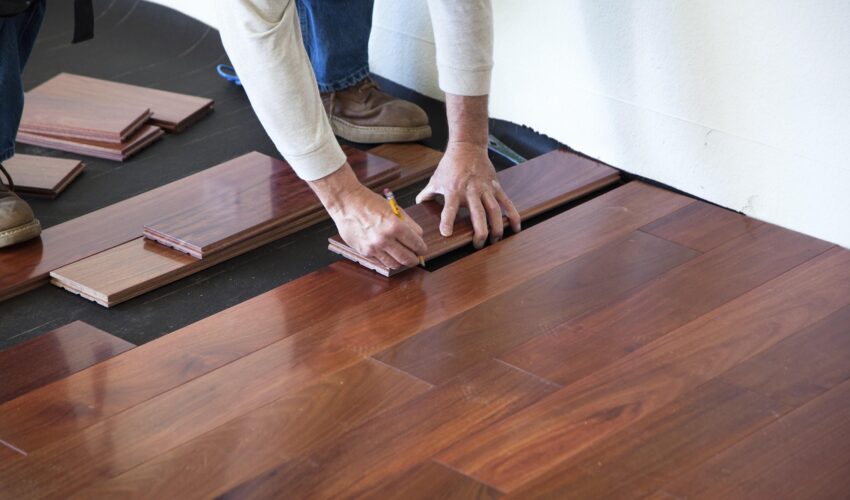Lifestyle and TrafficToday’s flooring industry offers a wide variety of hardwood flooring products designed to suit the lifestyle of every household or business. When selecting a hardwood floor, it’s important to think about the daily wear and tear it will endure and learn about the density and or hardness of different wood species.
If you have kids, pets or have a high traffic household you may want to consider a handscraped and distressed or wire-brushed hardwood which conceals small scratches and dents more than your standard smooth finished hardwood floor. However, if you desire a smooth finished hardwood floor, you should go with a dense and harder wood such as Brazilian Cherry or a Domestic White Oak coupled with a matte finish which will hold up better under heavy use.
Solid versus EngineeredStandard solid hardwood flooring is typically ¾” thick and is available in various widths. Solid hardwood flooring is exactly what it sounds like, solid wood throughout. Engineered hardwood flooring is offered anywhere from ⅜” up to ¾” in thickness and also comes in a wide range of widths. However, engineered flooring is made up of a layer of solid wood on top of numerous layers of soft lumber plywood.
The single most important benefit of this type of wood is its stability. Today’s trend of wide plank hardwood flooring is easily attainable with engineered products as opposed to solid products. Engineered hardwood is more stable in an environment where there is moisture. It is this stability that enables a homeowner to also have wood flooring in a basement.
Opting for an engineered product as opposed to a solid product allows for a larger tolerance in humidity, therefore requiring less effort by the homeowner to maintain their hardwood floors. 3 Prefinished versus Site FinishedWhat’s old is new again. Site on finish hardwood flooring is raw hardwood installed on site, sanded to a smooth finish then stained and finished to a custom look.
Today’s technology allows floor sanding technicians to match the level of quality and durability of prefinished products through this technique. Prefinished flooring is coated with aluminum oxide coatings resulting in a strong and durable finish. Leading manufacturers in the industry have developed finishing products that are comparable and much more durable than they were in the past.
Site on finish floors are ‘table top’ smooth meaning no beveled edges between the planks. Custom stain matching is also available with site on finish floors which may not be available from a prefinished selection of hardwoods. The single most important variable when deciding between the two types of wood is how long the installation will take and the overall cost. Prefinished floors upon installation are ready to use as opposed to site on finish flooring.
The steps involved in sanding, staining and finishing on site will increase the duration of the process to at least twice as long. If budget and time permits, the overall look is far superior of site on finish floors. Style of your HomeWhen choosing a wood floor, your personal style and tastes as well as the interior décor of your home should play a role in your selection.
In particular, you should look closely at your cabinetry, trim work, furniture and wall colours to make sure the wood you choose compliments the other design elements in your home. Also, be cautious about letting the current trends or fads dictate your floor selection – what’s cool today is often out-of-date tomorrow.
Although wide planks and grey palettes are in right now, take the time to pick a floor that will allow you to change and tweak your décor in the future without limiting your options. Neutral stains in floors along with solid or engineered products that have a good size wear layer will allow the possibility to match future décor and design choices. 5 Budget/CostsWhen budgeting for a flooring upgrade, you need to keep a few things in mind.
Don’t just focus on the per square foot price of a specific floor. Take into consideration what it will cost to get your floors installed. Installation rates are typically that, just the installation.Consider where the floor is going to be installed in your home.Removal and disposal of existing flooring needs to be considered, as well as manipulation of furniture.
Older homes may require extra work to correct high or low spots in the subfloor or refastening to eliminate squeaks. Perimeter baseboards and thresholds will be affected by a flooring change which too need to be factored into price.
Having the ability to move furniture around and prepare the area will decrease the overall cost of your project. If you’re a DIY type of person and want to do the installation yourself, take the time to choose a product that’s right for you. And ensure you know all of the product specifications and requirements by the manufacturer to keep your product warranty intact.
Talk with an expert today, hardwood floors come in a wide range of costs and design options to fit every budget and lifestyle. Make sure you ask a professional to visit your home and assess all the work required to be completed in addition to the installation.

